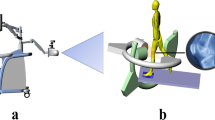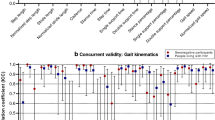Abstract
The validity of inertial sensor-based kinematic measurements in individuals with knee osteoarthritis has not previously been investigated. This study assessed the concurrent validity of inertial sensors in measuring knee kinematics in individuals with knee osteoarthritis when compared to the Vicon motion analysis system, and explored the difference between two calculation methods (traditional approach versus functional approach). Nineteen participants with knee osteoarthritis performed functional tasks with DorsaVi sensors (fixed with Vicon markers) worn on thighs and shanks. Peak and time-series knee flexion and extension (for both DorsaVi and Vicon systems) were calculated using the two calculation methods. Agreement between the systems was estimated by calculating root mean squared errors, mean differences and 95% limits of agreement. For the traditional approach, the root mean squared error between the DorsaVi and Vicon measurements ranged from 1.70°-3.02° for peak and 3.72–4.67° for time-series knee flexion and extension. For the functional approach, the root mean squared error ranged from 1.77°-3.18° for peak and 4.58°-5.04° for time-series knee flexion and extension. The mean difference varied across tasks (traditional approach: -0.16°-3.76°, functional approach: 0.96°-4.94°), and the limits of agreement showed high variability between the DorsaVi and Vicon measurements across the sample. Although there appears to be acceptable agreement between the systems for measuring knee kinematics, there was high variability in measurement differences across the dataset. In addition, a functional calibration approach does not appear to improve the accuracy of inertial sensor-based knee kinematics.




Similar content being viewed by others
Data availability
All data and materials are available upon reasonable request.
Code availability
Not applicable.
References
Cui A, et al. Global, regional prevalence, incidence and risk factors of knee osteoarthritis in population-based studies. E Clinic. Med. 2020;29–30
Vos T, et al. Years lived with disability (YLDs) for 1160 sequelae of 289 diseases and injuries 1990–2010: a systematic analysis for the Global Burden of Disease Study 2010. The Lancet. 2012;380(9859):2163–96.
Heidari B. Knee osteoarthritis prevalence, risk factors, pathogenesis and features: Part I. Caspian J Intern Med. 2011;2(2):205–12.
van der Straaten R, et al. Mobile assessment of the lower limb kinematics in healthy persons and in persons with degenerative knee disorders: A systematic review. Gait Posture. 2018;59:229–41.
Grimm B, Bolink S. Evaluating physical function and activity in the elderly patient using wearable motion sensors. EFORT Open Rev. 2016;1(5):112–20.
Calliess T, et al. Clinical evaluation of a mobile sensor-based gait analysis method for outcome measurement after knee arthroplasty. Sensors (Basel). 2014;14(9):15953–64.
Astephen J, Deluzio K. Changes in frontal plane dynamics and the loading response phase of the gait cycle are characteristic of severe knee osteoarthritis application of a multidimensional analysis technique. Clin Biomech. 2005;20(2):209–17.
Kaufman KR, et al. Gait characteristics of patients with knee osteoarthritis. J Biomech. 2001;34(7):907–15.
Chen CP, et al. Sagittal plane loading response during gait in different age groups and in people with knee osteoarthritis. Am J Phys Med Rehabil. 2003;82(4):307–12.
Baliunas AJ, et al. Increased knee joint loads during walking are present in subjects with knee osteoarthritis. Osteoarthritis Cartilage. 2002;10(7):573–9.
Smith AJ, Lloyd DG, Wood DJ. Pre-surgery knee joint loading patterns during walking predict the presence and severity of anterior knee pain after total knee arthroplasty. J Orthop Res. 2004;22(2):260–6.
Al-Zahrani KS, Bakheit AMO. A study of the gait characteristics of patients with chronic osteoarthritis of the knee. Disabil Rehabil. 2009;24(5):275–80.
Gök H, Ergin S, Yavuzer G. Kinetic and kinematic characteristics of gait in patients with medial knee arthrosis. Acta Orthop Scand. 2011;73(6):647–52.
Heiden TL, Lloyd DG, Ackland TR. Knee joint kinematics, kinetics and muscle co-contraction in knee osteoarthritis patient gait. Clin Biomech. 2009;24(10):833–41.
Childs JD, et al. Alterations in lower extremity movement and muscle activation patterns in individuals with knee osteoarthritis. Clin Biomech. 2004;19(1):44–9.
Vlaeyen JW, Linton SJ. Fear-avoidance model of chronic musculoskeletal pain: 12 years on. Pain. 2012;153(6):1144–7.
Vlaeyen JW, Linton SJ. Fear-avoidance and its consequences in chronic musculoskeletal pain: a state of the art. Pain. 2000;85(3):317–32.
Picerno P. 25 years of lower limb joint kinematics by using inertial and magnetic sensors: A review of methodological approaches. Gait Posture. 2017;51:239–46.
Grood ES, Suntay WJ. A Joint Coordinate System for the Clinical Description of Three-Dimensional Motions: Application to the Knee. J Biomech Eng. 1983;105(2):136–44.
Wu G, et al. ISB recommendation on definitions of joint coordinate system of various joints for the reporting of human joint motion- part I: ankle, hip and spine. J Biomech. 2002;35:543–8.
Wu G, et al. ISB recommendations on definitions of joint coordinate systems of various joints for the reporting of human joint motion-Part II: shoulder, elbow, wrist and hand. J Biomech. 2005;38:981–92.
Seel T, Raisch J, Schauer T. IMU-based joint angle measurement for gait analysis. Sensors (Basel). 2014;14(4):6891–909.
Favre J, et al. Functional calibration procedure for 3D knee joint angle description using inertial sensors. J Biomech. 2009;42(14):2330–5.
Cuesta-Vargas AI, Galan-Mercant A, Williams JM. The use of inertial sensors system for human motion analysis. Phys Ther Rev. 2010;15(6):462–73.
Poitras I, et al, Validity and Reliability of Wearable Sensors for Joint Angle Estimation: A Systematic Review. Sensors (Basel, 2019;19(7)
Al-Amri M, et al. Inertial Measurement Units for Clinical Movement Analysis: Reliability and Concurrent Validity. Sensors (Basel), 2018;18(3)
Zhang JT, et al. Concurrent validation of Xsens MVN measurement of lower limb joint angular kinematics. Physiol Meas. 2013;34(8):N63–9.
Mjosund HL, et al. Clinically acceptable agreement between the ViMove wireless motion sensor system and the Vicon motion capture system when measuring lumbar region inclination motion in the sagittal and coronal planes. BMC Musculoskelet Disord. 2017;18(1):124.
Drapeaux A, Carlson K. A Comparison of Inertial Motion Capture Systems: DorsaVi and Xsens. Internatl J Kinesiol Sports Sci. 2020;8(3)
Hinman RS, et al. Acupuncture for chronic knee pain: a randomized clinical trial. JAMA. 2014;312(13):1313–22.
Kulkarni K, et al. Obesity and osteoarthritis. Maturitas. 2016;89:22–8.
Thijssen E, van Caam A, van der Kraan PM. Obesity and osteoarthritis, more than just wear and tear: pivotal roles for inflamed adipose tissue and dyslipidaemia in obesity-induced osteoarthritis. Rheumatology (Oxford). 2015;54(4):588–600.
Blagojevic M, et al. Risk factors for onset of osteoarthritis of the knee in older adults: a systematic review and meta-analysis. Osteoarthritis Cartilage. 2010;18(1):24–33.
National Institute for Health and Care Excellence. Osteoarthritis: care and management (clinical guideline CG177). 2014 [cited 2021 1 March]; Available from: https://www.nice.org.uk/guidance/cg177/resources/osteoarthritis-care-and-management-pdf-35109757272517
Roos EM, et al. Knee injury and osteoarthritis outcome score (KOOS) - Development of a self-administered outcome measure. J Orthop Sports Phys Ther. 1998;28(2):88–96.
Xsens Technologies B.V. MVN User Manual: User Guide MVN, MVN BIOMECH MVN Link, MVN Awinda. [accessed on 29 January 2021]; Available from: https://fccid.io/QILMTW2-3A7G6/User-Manual/Users-Manual-2695756
Roetenberg D, Luinge H, Slycke P. Xsens MVN: Full 6DOF Human Motion Tracking Using Miniature Inertial Sensors. Xsens Motion Technologies BV, Tech Rep 2009
Besier TF, et al. Repeatability of gait data using a functional hip joint centre and a mean helical knee axis. J Biomech. 2003;36:1159–68.
Cutti AG, et al. ‘Outwalk’: a protocol for clinical gait analysis based on inertial and magnetic sensors. Med Biol Eng Compu. 2010;48(1):17.
Bolink SA, et al. Validity of an inertial measurement unit to assess pelvic orientation angles during gait, sit-stand transfers and step-up transfers: Comparison with an optoelectronic motion capture system. Med Eng Phys. 2016;38(3):225–31.
Bland JaAD, Bland and Altman (2007) - Agreement.pdf. J Biopharm Stat. 2007;17(4):571–582
Kok M, Schon TB. Magnetometer Calibration Using Inertial Sensors. IEEE Sens J. 2016;16(14):5679–89.
Vitali RV, McGinnis RS, Perkins NC. Robust Error-State Kalman Filter for Estimating IMU Orientation. IEEE Sensors J. 2020;1–1
Kalman RE. A New Approach to Linear Filtering and Prediction Problems. J Basic Eng. 1960;82(1):35–45.
Findlow A, et al. Predicting lower limb joint kinematics using wearable motion sensors. Gait Posture. 2008;28(1):120–6.
Gholami M, Napier C, Menon C. Estimating Lower Extremity Running Gait Kinematics with a Single Accelerometer: A Deep Learning Approach. Sensors (Basel), 2020;20(10)
Argent R, et al. Evaluating the use of machine learning in the assessment of joint angle using a single inertial sensor. J Rehabil Assist Technol Eng. 2019;6:2055668319868544.
Lim H, Kim B, Park S. Prediction of Lower Limb Kinetics and Kinematics during Walking by a Single IMU on the Lower Back Using Machine Learning. Sensors (Basel) 2019;20(1)
Goulermas JY, et al. Regression Techniques for the Prediction of Lower Limb Kinematics. J Biomech Eng. 2005;127(6):1020–4.
Rapp E, et al. Estimation of kinematics from inertial measurement units using a combined deep learning and optimization framework. J Biomech, 2021;116:110229
Mundt M, et al. Prediction of lower limb joint angles and moments during gait using artificial neural networks. Med Biol Eng Comput. 2020;58(1):211–25.
Ceseracciu E, Sawacha Z, Cobelli C. Comparison of markerless and marker-based motion capture technologies through simultaneous data collection during gait: proof of concept. PLoS One 2014;9(3):e87640
Takeda R, et al. Gait posture estimation using wearable acceleration and gyro sensors. J Biomech. 2009;42(15):2486–94.
Funding
No funding was received for conducting this study.
Author information
Authors and Affiliations
Contributions
Tara Binnie: Conceptualisation, Methodology, Formal Analysis, Investigation, Data Curation, Writing – Original Draft, Writing – Review and Editing. Anne Smith: Conceptualisation, Methodology, Formal Analysis, Writing – Review and Editing, Supervision. Peter Kent: Conceptualisation, Methodology, Formal Analysis, Writing – Review and Editing, Supervision. Leo Ng: Conceptualisation, Writing – Review and Editing. Peter O’Sullivan: Conceptualisation, Writing – Review and Editing. Jay-Shian Tan: Investigation, Data Curation, Writing – Review and Editing. Paul Davey: Methodology, Software, Data Curation, Writing – Review and Editing. Amity Campbell: Conceptualisation, Methodology, Writing – Review and Editing, Supervision.
Corresponding author
Ethics declarations
Ethics approval
The study was approved by the Curtin University Human Research Ethics Committee (HRE2017-0695) and was conducted in accordance with the NHMRC National Statement on Ethical Conduct in Research Involving Humans.
Consent to participate
All participants were provided with a participant information sheet and were required to provide written informed consent.
Consent for publication
Not applicable.
Conflicts of interest
The DorsaVi company provided training, technical support and the equipment at a reduced price. The company was not involved in the study design, data collection, data handling or data analysis and did not influence the reporting of the results or conclusions reached in this study. A decade ago, Peter Kent received a market-rate consulting fee from DorsaVi for advice on clinical trial design. No member of the project team has any other direct or indirect financial link to the DorsaVi company.
Additional information
Publisher's Note
Springer Nature remains neutral with regard to jurisdictional claims in published maps and institutional affiliations.
Rights and permissions
About this article
Cite this article
Binnie, T., Smith, A., Kent, P. et al. Concurrent validation of inertial sensors for measurement of knee kinematics in individuals with knee osteoarthritis: A technical report. Health Technol. 12, 107–116 (2022). https://doi.org/10.1007/s12553-021-00616-9
Received:
Accepted:
Published:
Issue Date:
DOI: https://doi.org/10.1007/s12553-021-00616-9




